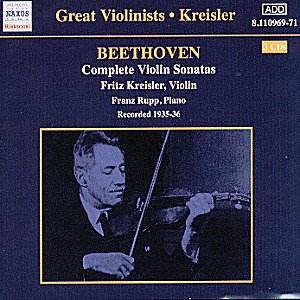One of the first of the HMV Society Editions - the
famous subscription albums - this was also the first complete
set of the Beethoven Violin Sonatas ever to be recorded. The catalogues
had previously been sparse - isolated Sonatas, mainly the Op 30/3,
the Spring and the Kreutzer by disparate musicians. For these
sessions, overseen by Fred Gaisberg, Franz Rupp was chosen as
accompanist, a suggestion made by Kreisler. The violinist may
or may not have know that Rupp had accompanied the ageing but
still potent Willy Burmester during one of the egotistical German
violinist's many World tours. In any case Rupp's most distinguished
accompanying days were ahead of him - here he was still only intermittently
effective. The original sessions were begun - but aborted - in
Berlin and only successfully completed in London and these lyrical,
affectionate performances are still notably impressive, in the
main for Kreisler's highly individual approach, his personalised
vibrato usage, lyrical ease, and battery of inflective and ear-warming
tonal qualities.
In the E flat major, for example, Kreisler inflects the opening
Allegro con spirito with wonderful colouration, intensifying his
vibrato in the second subject - in depth and width - with sovereign
ardour (albeit one that may seem somewhat sentimentalised to those
unsympathetic to this idiom). The following Adagio is beautifully
phrased - in the main the slow movements are utterly convincing
- and heightened with affectionate delicacy, his portamenti chaste,
using a long bow (one never gets the sense of him changing bow,
such was his command) and unfolding a glorious, lyric cantilena.
He constantly changes colour, speed of vibrato and weight of muscular
"pull" - in fact a master class in colouration and expressive
nuance. To the articulacy and fluency of the concluding Rondo
finale comes genuine rhythmic élan. If one listens to the
Spring Sonata one hears Kreisler's inimitable charm in the opening
Allegro - where Rupp is also on good form - and the intense sense
of emotive compression Kreisler could generate in the slow movement.
Here, once again, his trills are highly personalised and the colour
and shaping of the line is indubitably his alone. In the rondo
finale Rupp is really rather too supine; Kreisler meanwhile catches
the stoical quality of the music with unexpected intensity. He
is equally attuned to the incipient stoutness of it and he characterises
with his intensely vibrant tone, though one or two minor slips
intrude. Once more lyricism and elegance vie for honours in this
splendid performance.
The Kreutzer doesn't quite scale these heights. The tempo for
the opening violin statement is reasonable but Rupp's response
is distinctly slower. I admired anew the tonal increments in which
Kreisler indulges, though he's not helped here by Rupp's occasional
rhythmic waywardness, and in the circumstances there is some disruptive
rhythm in the middle of the movement that does some damage to
the performance. The variations second movement is notable for
some more of the violinist's battery of devices; in this case
he employs pervasive portamenti with audible intermediate notes
and this gives a whole increased sense of nuance and colour to
the sound. All in all though, despite many glorious moments this
is not a Kreutzer that ranks with the greatest. The final sonata,
the G major Op 96, receives a patrician reading full of Kreisler's
greatest qualities as a communicative musician. He contours and
colours the Allegro moderato with wonderful grace. In the slow
movement the introduction by Rupp is very plain but Kreisler reserves
greatest intensity of vibrato usage for the most optimum expressive
moment. He ends the movement with the quickest and most dextrous
of slides. Kreisler controls the burgeoning drama of the Poco
Allegretto finale with perfectly judged lyricism - his diminuendi
are subtle and controlled, his tone ardently alive.
There is much, much more here to satisfy the Kreisler devotee.
Maybe he was slightly past his best years but this integral and
first set of the Sonatas is still a cornerstone of the discography.
Not everything comes off (parts of the A major, Op 30 No 1 for
example) and the partnership between Kreisler and Rupp is uneven
and unequal, but at super bargain price these transfers do the
performances justice in the most generous way imaginable.
Jonathan Woolf
see also review
by Tony haywood
